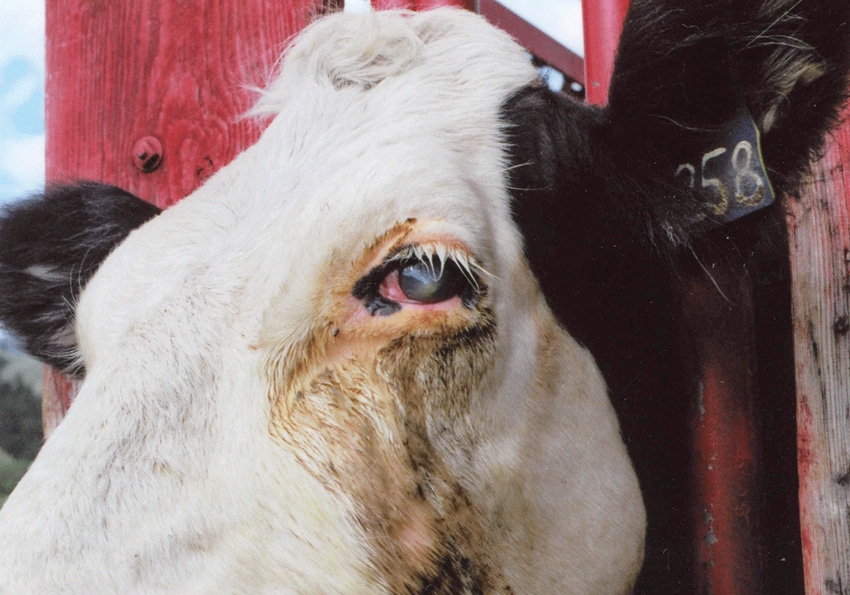There are many strains of M. bovis and M. bovoculi, and there are several vaccines available. In order to be effective, the vaccine strain and the field strain must be the same or closely related.
April 7, 2020

When I was growing up, infectious bovine keratoconjunctivitis (IBK, or pinkeye) in cattle was rather common and relatively easy to treat. An eye patch and a long-acting oxytetracycline injection was often very effective, if IBK was detected early.
IBK normally occurs from midsummer through early fall. Calves are typically the most severely affected, as that time of year creates the IBK version of the “perfect storm.”
Fly populations are at their peak; fly tags administered in April or May are losing their efficacy; the calf’s colostral immunity is waning; grasses are maturing, allowing for injury and irritation to the eye; and cattle bunch up under shade, permitting more fly contact among animals.
IBK is still rather common, but treatment is not as successful as it once was. The reasons for this poor response to treatment are as complex as the disease itself. It is estimated that IBK costs the beef industry $150 million annually.
Calves with “bad eyes” often are discounted when sold, and the pain IBK causes can negatively affect gain. Some reports indicate IBK infection may decrease weaning weights as much as 35 pounds.
Historically, Moraxella bovis has been considered the primary IBK pathogen. More recently, mixed cultures of M. bovis, Moraxella bovoculi and Mycoplasma species have been recovered from IBK cases.
If IBK is to be controlled, dedication to management practices is required for the best success. One of the most important management factors is fly control. Flies can carry the disease from animal to animal and are attracted to the watery eyes associated with IBK. Fly tags, fly sprays, pour-ons, dust bags, back oilers and premise sprays can all be used to help control flies.
Beef producers tend to apply fly tags in April or May, because that is when cows and calves are handled for vaccinations and branding. Unfortunately, the efficacy of fly tags is often starting to wane by the time IBK season emerges.
It may be necessary to either delay fly tag application until a later date (which means an extra herd handling), or to apply fly sprays, pour-ons or other methods described above as the tag efficacy declines.
Corneal damage opens the door to IBK infection. This can occur from flies or other objects in the environment. As calves mature and start to graze, they become exposed to grass seeds, pollen and mature grass stems — especially in areas where cool-season grasses predominate.
Sunlight can also irritate the eye, particularly in calves with light-pigmented skin. Anything that irritates the eye will cause tearing, which attracts flies. If the cornea isn’t already damaged, the flies themselves can injure the cornea and carry the infection to the eye at the same time.
Moraxella bovis has finger-like projections (pili) that allow the bacteria to bind to the damaged cornea. Once it binds, it reproduces rapidly.
Moraxella bovoculi, on the other hand, does not have pili so it doesn’t bind well to the cornea — but it is able to attach to the M. bovis that has already bound to the damaged cornea. M. bovoculi can quickly reproduce and may overwhelm the M. bovis population.
The effectiveness of IBK vaccines has long been debated. It’s very difficult to scientifically demonstrate IBK vaccine efficacy. However, many veterinarians and producers believe vaccination does help reduce IBK severity and aids in prevention when used in combination with good management practices.
There are many strains of M. bovis and M. bovoculi, and there are several vaccines available. In order to be effective, the vaccine strain and the field strain must be the same or closely related.
Again, the importance of good management practices cannot be overstated. Ask your veterinarian about the experience with IBK vaccines in your area, fly control and environmental management to develop a comprehensive control program.
Sjeklocha is a technical services veterinarian for Merck Animal Health. He can be reached at [email protected].
About the Author(s)
You May Also Like





